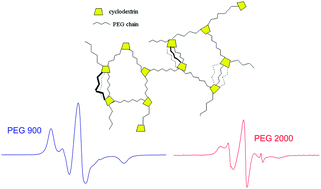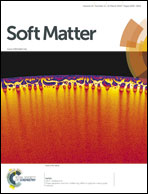Properties of polyethylene glycol/cyclodextrin hydrogels revealed by spin probes and spin labelling methods†
Abstract
The properties of a gel consisting of a covalent network formed by the reaction of isocyanate end-capped polyethylene glycol (PEG) with β-cyclodextrin, were investigated by EPR spectroscopy. Spin-labelled cyclodextrin was incorporated into the cross-link points of the gel and at the chain ends. The dynamics of the gel fibres as reported by the spin label, was found to be sensitive to the H-bonding ability of the solvent, density of cross-links and temperature. Addition of spin probes (e.g., TEMPO and adamantane-TEMPO) to the unlabelled gel made it possible to characterise the solvent pools in the gel. While TEMPO was uniformly distributed throughout the solvent pools, the adamantane derivative was located at the gel fibre-solvent pool interface; these two probes thus reported on the different locations in the solvent pools. At low temperature, the gels were shown to prevent ice crystallisation in the solvent pools resulting in the formation of supercooled water. Both probes showed that the water froze at ca. 250 K, thus suggesting that the properties of the supercooled water are uniform across the solvent pools.


 Please wait while we load your content...
Please wait while we load your content...